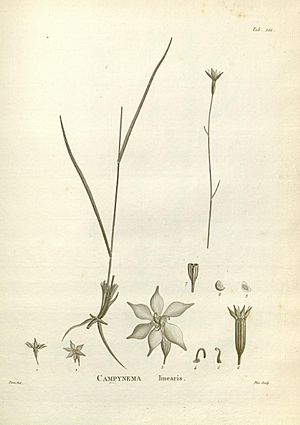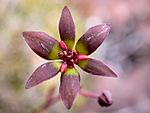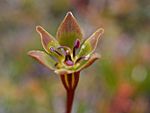Campynema facts for kids
Campynema is a special group of plants with only one known type, called Campynema lineare. This unique plant lives only on the island of Tasmania in Australia. It's part of a plant family called Campynemataceae. Its closest plant relative, Campynemanthe, lives far away in New Caledonia.
Quick facts for kids Campynema |
|
|---|---|
 |
|
| Campynema lineare Labill. | |
| Scientific classification | |
| Genus: |
Campynema
|
| Species: |
lineare
|
| Synonyms | |
|
Campynema pygmaeum F.Muell. ex Benth. |
|
Meet the Green Mountain Lily
C. lineare is also known as the green mountain lily. It's a small plant that stands upright, growing about 15 to 30 centimeters tall. It has one main curved leaf near its base. Smaller leaves grow higher up its flower stem.
The plant is easy to spot because of its amazing green flower. This flower usually blooms in the summer. It often grows by itself and has six green petals, called tepals. Sometimes, these petals have a bit of a burgundy color. As they get older, their edges can turn brown.
The plant has special parts called anthers that hold pollen. Its seeds are flat and have a soft outer layer. C. lineare is a geophyte, which means it grows from an underground part, like a bulb. Its leaves fall off in winter, but they grow back in spring.
Scientists believe C. lineare is very old, about 57 million years old! It's an important part of Tasmania's ancient plant life. Studies show that its plant family, Campynemataceae, is the oldest group in the plant order Liliales.
Long ago, C. lineare was thought to be part of the Liliaceae family, which includes lilies.
- Variation in flower coloration
Where Does It Grow?
You can find C. lineare in wet, boggy areas. It grows in the central, western, and central mountains of Tasmania. It prefers places that are high up, like subalpine and alpine regions.
This plant often lives in grassy fields called herbfields. It also grows in heathlands, which are areas with small shrubs. You can find it in special plant communities called cushion plant communities and along the edges of lakes.
Protecting This Special Plant
C. lineare is mostly safe because it grows in protected areas. However, some of the places it lives might be harmed by climate change. Scientists predict that alpine grasslands and cushion plant areas in Australia could shrink.
Because C. lineare is a very old and unique plant (a palaeoendemic), the Tasmanian Parks and Wildlife Service considers it very important to protect.
See also
 In Spanish: Campynema para niños
In Spanish: Campynema para niños




